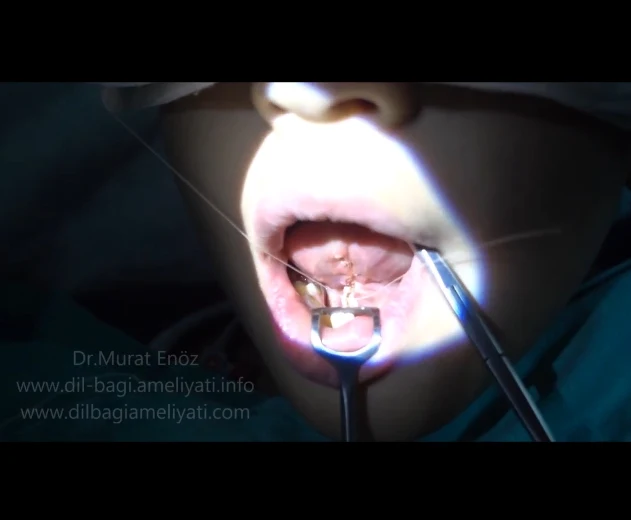Tongue Tie Release Surgery
Video Description: In tongue ties that do not reach the tongue (especially in Type 3 anterior tongue tie), diagnosis and treatment may be delayed. On the video an patients who 10 years old and had complaints of spoken impairment when speaking rapidly and tongue tearing on the upper part of the mouth when the mouth was fully open it was seen that there was a type 3 anterior tongue tie on the examination and the Eiffel Tower Type or Piston Type Tongue Tie mentioned earlier. Local anesthetic and serum physiological mixture was injected into the tongue tie before the procedure and then the tongue was cut off with the Thermal welding device. After the procedure, the incision was sutured with a absorbable stitches. The incision area under the tongue after the procedure is seen at the end of the video. Suturing the incision site vertically may reduce the possibility of wound reattachment. This operation was performed under the patient's sedation anesthesia with oral gas, without inserting the intubation tube.
Frenectomy or Frenotomy?
The surgical procedure that I share with you in this video is the simple tongue tie cutting (frenotomy) technique. Apart from this, frenectomy technique, which includes removing triangular tissue from tongue tie tissue, may reduce the possibility of re-attachment after surgery.
Tongue Tie Release May Helpful For Articulation Problems?
A Technique Reducing Heat Damage, Tongue Tie Release Surgery With Thermal Welding Device
Thermal welding device is a device that can reduce heat dissipation in the incision area and possible nerve damage due to it. The probe of this device, which is normally produced for use in tonsil surgery, is also suitable for tongue tie surgery. When tongue tie cutting is performed with devices such as various laser types, cautery, radiofrequency, even if the operation is terminated without any problems; There may be nerve damage in areas adjacent to the incision, and often the branches of the ligual nerve are damaged. responsible for the movement of tongue.
Is Tongue Tie Release Surgery With Thermal Welding Device Too Painful?
Although the thermal welding device reduces the heat dissipation in the incision area and the possible nerve damage due to this, pain may occur in the first 3 days after the procedure. Generally, swelling and pain increase under the tongue may be evident for up to a few days, and it usually decreases after 1 week. In this process, it may be recommended to apply cold (ice cream, ice contact) under the tongue and to use local pain relief products.
How Long Does It Take to Complete Recovery After Tongue Tie Release Surgery With Thermal Welding Device?
Generally, the complete healing of the incision under the tongue takes 3 weeks. Soluble suture materials under the tongue are self-dissolving up to 3 weeks.
Tongue Tie Release Surgery Indications
Tongue tie release surgery should be performed when infants have nutritional disorders, poor weight gain, swallowing problems (gas, reflux or colic pain), and when breastfeeding counseling services are not sufficient.
It can be done in older children when speech disorders, articulation problems, and effects on the jaw and mouth structure are detected.
The tongue functions like a muscular organ responsible for shaping the jaw and facial bones. Normally, it is very important for babies to sit in the mouth towards the upper palate (sleeping posture of tongue). In order for a baby to do this during sleep, there should be no nasal congestion and tongue tie. If the tongue is positioned upwards in this way, the upper jaw grows laterally and forward (it works like an expander) and the lower jaw grows forward. In babies with nasal congestion, since their mouth breathing is dependent, they do not lift their tongues up and cannot do this tongue posture. In children with untreated tongue tie, a decrease in the retrolingual away can lead to a permanent predisposition to sleep apnea (source article link >> Is ankyloglossia associated with obstructive sleep apnea?).
Links to find detailed information about the subject>> http://www.dilbagiameliyati.com/
Dil bağı ile ilgili olarak bu web sitesinde makeler ulaşmak için tıklayabileceğiniz link grubu >> https://www.ent-istanbul.com/search?q=tongue+tie
Murat Enoz, MD, Otorhinolaryngology, Head and Neck Surgeon - ENT Doctor in Istanbul
Private Office:
Address: İncirli Cad. No:41, Kat:4 (Dilek Patisserie Building), Postal code: 34147, Bakırköy - İstanbul
Appointment Phone: +90 212 561 00 52
Appointment Phone: +90 212 561 00 52
Fax: +90 212 542 74 47



Comments
Post a Comment